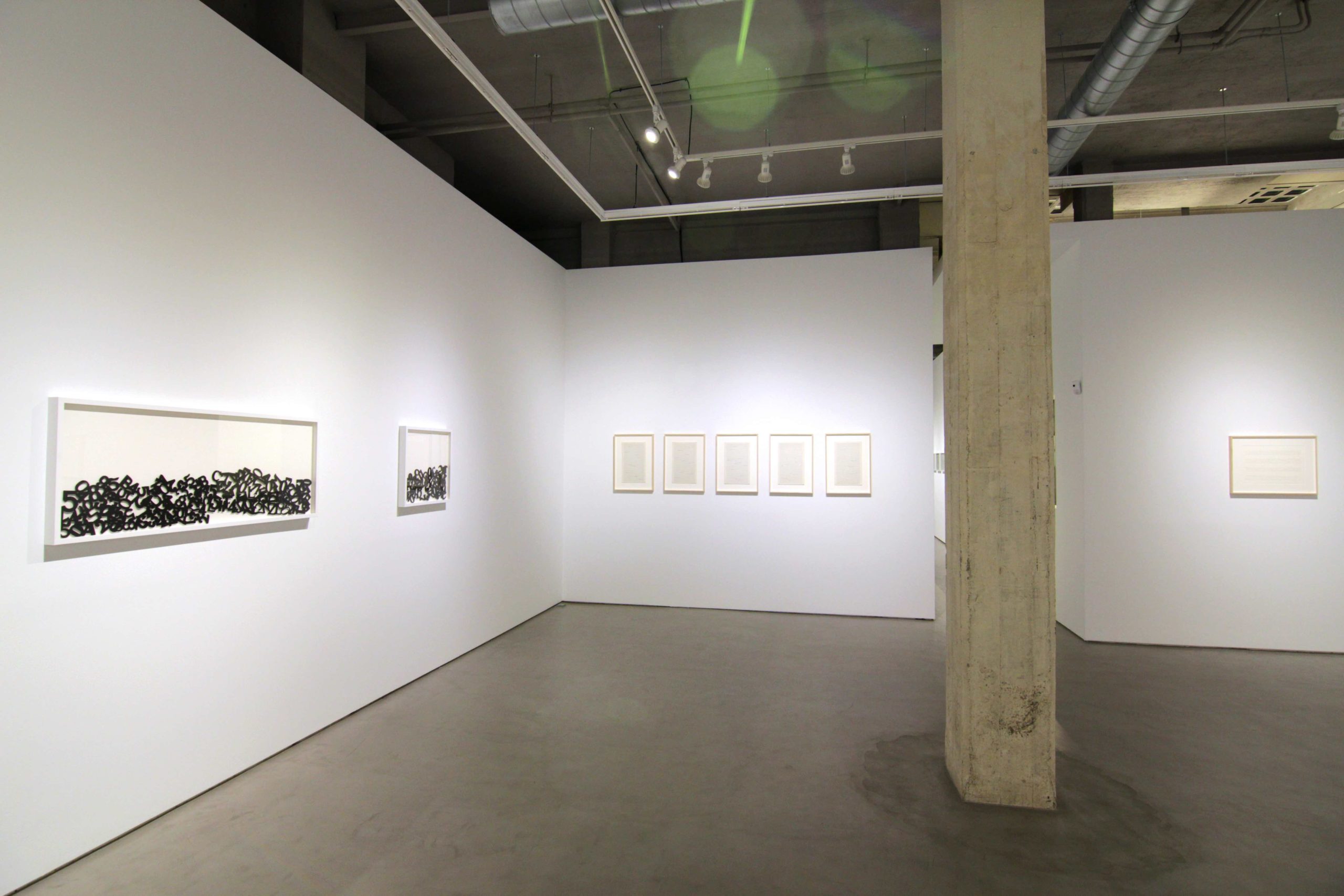Gallery façade. November 2016. Exhibition view. Cercas. 2016, typed text on old notarial paper. Exhibition view. Planos (Bogotá). 2008, 35 x 43 cm, handwritten ink on paper. Exhibition view. Palabras…
Read More
JTNDZGl2JTIwY2xhc3MlM0QlMjJjb2wlMjBzY3JvbGxUcmljazIlMjIlM0UlMDklMDklMEElMjAlMjAlMjAlM0NkaXYlMjBjbGFzcyUzRCUyMmhpZGVTY3JvbGxCYXIlMjIlM0UlMEElMjAlMjAlMjAlMjAlM0NkaXYlMjBzdHlsZSUzRCUyMnBhZGRpbmctdG9wJTNBJTIwMzVweCUzQiUyMiUzRSUzQyUyRmRpdiUzRSUwQSUwQSUyMCUyMCUyMCUyMCUzQ2ltZyUyMHNyYyUzRCUyMmh0dHBzJTNBJTJGJTJGZ2FsZXJpYW1wYS5jb20lMkZ3cC1jb250ZW50JTJGdXBsb2FkcyUyRjIwMjAlMkYwOSUyRk1QQV9BUlRCT18yMDE2XzAxLmpwZyUyMiUzRSUwQSUyMCUyMCUyMCUyMCUwOSUzQ3AlMjBjbGFzcyUzRCUyMnBpZU9icmElMjIlM0VJbnN0YWxsYXRpb24lMjB2aWV3JTJDJTIwQVJUQk8lMkMlMjAyMDE2LiUzQyUyRnAlM0UlMEElMEElM0NpbWclMjBzcmMlM0QlMjJodHRwcyUzQSUyRiUyRmdhbGVyaWFtcGEuY29tJTJGd3AtY29udGVudCUyRnVwbG9hZHMlMkYyMDIwJTJGMDklMkZNUEFfQVJUQk9fMjAxNl8wMi5qcGclMjIlM0UlMEElMjAlMjAlMjAlMjAlMDklM0NwJTIwY2xhc3MlM0QlMjJwaWVPYnJhJTIyJTNFSW5zdGFsbGF0aW9uJTIwdmlldyUyQyUyMEFSVEJPJTJDJTIwMjAxNi4lM0MlMkZwJTNFJTBBJTBBJTNDaW1nJTIwc3JjJTNEJTIyaHR0cHMlM0ElMkYlMkZnYWxlcmlhbXBhLmNvbSUyRndwLWNvbnRlbnQlMkZ1cGxvYWRzJTJGMjAyMCUyRjA5JTJGTVBBX0FSVEJPXzIwMTZfMDMuanBnJTIyJTNFJTBBJTIwJTIwJTIwJTIwJTA5JTNDcCUyMGNsYXNzJTNEJTIycGllT2JyYSUyMiUzRVRvbnklMjBPdXJzbGVyJTJDJTIwYy1VeCUyQyUyMDIwMTYlMkMlMjA5NCUyMHglMjA2MiUyMGNtJTJDJTIwQWx1bWluaXVtJTJDJTIwcGFpbnQlMkMlMjBzY3JlZW4lMjBhbmQlMjB2aWRlbyUyMHBsYXllciUyMC4lM0MlMkZwJTNFJTBBJTBBJTNDaW1nJTIwc3JjJTNEJTIyaHR0cHMlM0ElMkYlMkZnYWxlcmlhbXBhLmNvbSUyRndwLWNvbnRlbnQlMkZ1cGxvYWRzJTJGMjAyMCUyRjA5JTJGTVBBX0FSVEJPXzIwMTZfMDQuanBnJTIyJTNFJTBBJTIwJTIwJTIwJTIwJTA5JTNDcCUyMGNsYXNzJTNEJTIycGllT2JyYSUyMiUzRVRvbnklMjBPdXJzbGVyJTJDJTIwUHJvcGVydGllcyUyMDIwMTAtMyUyQyUyMDIwMTYlMkMlMjAxNTAlMjB4JTIwMTMwJTIweCUyMDUwJTIwY20lMkMlMjBJbnN0YWxsYXRpb24uJTNDJTJGcCUzRSUwQSUwQSUzQ2ltZyUyMHNyYyUzRCUyMmh0dHBzJTNBJTJGJTJGZ2FsZXJpYW1wYS5jb20lMkZ3cC1jb250ZW50JTJGdXBsb2FkcyUyRjIwMjAlMkYwOSUyRk1QQV9BUlRCT18yMDE2XzA1LmpwZyUyMiUzRSUwQSUyMCUyMCUyMCUyMCUwOSUzQ3AlMjBjbGFzcyUzRCUyMnBpZU9icmElMjIlM0VWaWN0b3JpYSUyMENpdmVyYSUyQyUyMFNhcm8lMkMlMjAyMDE1JTJDJTIwNjYlMjB4JTIwNDYlMjB4bSUyQyUyMFBhaW50aW5nJTIwb24lMjBtZXRhbC4lM0MlMkZwJTNFJTBBJTBBJTNDaW1nJTIwc3JjJTNEJTIyaHR0cHMlM0ElMkYlMkZnYWxlcmlhbXBhLmNvbSUyRndwLWNvbnRlbnQlMkZ1cGxvYWRzJTJGMjAyMCUyRjA5JTJGTVBBX0FSVEJPXzIwMTZfMDYuanBnJTIyJTNFJTBBJTIwJTIwJTIwJTIwJTA5JTNDcCUyMGNsYXNzJTNEJTIycGllT2JyYSUyMiUzRUFudG9uaSUyME11bnRhZGFzJTJDJTIwTWlyYXIlMjBWZXIlMjBQZXJjaWJpciUyQyUyMDIwMDklMkMlMjA1MCUyMHglMjAxOTAlMjB4JTIwMjIlMjBjbSUyQyUyMERlc2slMjBsYW1wcyUyMGFuZCUyMHdhbGwlMjBzdGlja2Vycy4lM0MlMkZwJTNFJTBBJTBBJTNDaW1nJTIwc3JjJTNEJTIyaHR0cHMlM0ElMkYlMkZnYWxlcmlhbXBhLmNvbSUyRndwLWNvbnRlbnQlMkZ1cGxvYWRzJTJGMjAyMCUyRjA5JTJGTVBBX0FSVEJPXzIwMTZfMDcuanBnJTIyJTNFJTBBJTIwJTIwJTIwJTIwJTA5JTNDcCUyMGNsYXNzJTNEJTIycGllT2JyYSUyMiUzRUFudG9uaSUyME11bnRhZGFzJTJDJTIwV2UlMjBhcmUlMjBmYW50YXN0aWMlMjAlMjhVcnVndWF5JTI5JTJDJTIwMjAwNSUyQyUyMDcwJTIweCUyMDEwMCUyMGNtJTJDJTIwU2lsa3NjcmVlbiUyMHByaW50LiUzQyUyRnAlM0UlMEElMEElM0NpbWclMjBzcmMlM0QlMjJodHRwcyUzQSUyRiUyRmdhbGVyaWFtcGEuY29tJTJGd3AtY29udGVudCUyRnVwbG9hZHMlMkYyMDIwJTJGMDklMkZNUEFfQVJUQk9fMjAxNl8wOC5qcGclMjIlM0UlMEElMjAlMjAlMjAlMjAlMDklM0NwJTIwY2xhc3MlM0QlMjJwaWVPYnJhJTIyJTNFQW50b25pJTIwTXVudGFkYXMlMkMlMjBDb2xvbWJpYSUyMGlzJTIwZG9pbmclMjB3ZWxsJTIwJTI4Q29sb21iaWElMjklMkMlMjAxOTk5JTJDJTIwNTIlMjB4JTIwMTAwJTIwY20lMkMlMjBTaWxrc2NyZWVuJTIwcHJpbnQuJTNDJTJGcCUzRSUwQSUwQSUzQ2ltZyUyMHNyYyUzRCUyMmh0dHBzJTNBJTJGJTJGZ2FsZXJpYW1wYS5jb20lMkZ3cC1jb250ZW50JTJGdXBsb2FkcyUyRjIwMjAlMkYwOSUyRk1QQV9BUlRCT18yMDE2XzA5LmpwZyUyMiUzRSUwQSUyMCUyMCUyMCUyMCUwOSUzQ3AlMjBjbGFzcyUzRCUyMnBpZU9icmElMjIlM0VBbnRvbmklMjBNdW50YWRhcyUyQyUyMFR1ZG8lMjBiZW0lMkMlMjBUdWRvJTIwYm9tJTIwJTI4QnJhc2lsJTI5JTJDJTIwMTk5OSUyQyUyMDQ4JTIweCUyMDEwMCUyMGNtJTJDJTIwU2lsa3NjcmVlbiUyMHByaW50LiUzQyUyRnAlM0UlMEElMEElM0NpbWclMjBzcmMlM0QlMjJodHRwcyUzQSUyRiUyRmdhbGVyaWFtcGEuY29tJTJGd3AtY29udGVudCUyRnVwbG9hZHMlMkYyMDIwJTJGMDklMkZNUEFfQVJUQk9fMjAxNl8xMC5qcGclMjIlM0UlMEElMjAlMjAlMjAlMjAlMDklM0NwJTIwY2xhc3MlM0QlMjJwaWVPYnJhJTIyJTNFQW50b25pJTIwTXVudGFkYXMlMkMlMjBMbyUyMGhlY2hvJTIwZW4lMjBNJUMzJUE5eGljbyUyMGVzdCVDMyVBMSUyMGJpZW4lMjBoZWNobyUyMCUyOE0lQzMlQTl4aWNvJTI5JTJDJTIwMjAwNCUyQyUyMDY4JTIweCUyMDEwMCUyMGNtJTJDJTIwU2lsa3NjcmVlbiUyMHByaW50LiUzQyUyRnAlM0UlMEElMEElM0NpbWclMjBzcmMlM0QlMjJodHRwcyUzQSUyRiUyRmdhbGVyaWFtcGEuY29tJTJGd3AtY29udGVudCUyRnVwbG9hZHMlMkYyMDIwJTJGMDklMkZNUEFfQVJUQk9fMjAxNl8xMS5qcGclMjIlM0UlMEElMjAlMjAlMjAlMjAlMDklM0NwJTIwY2xhc3MlM0QlMjJwaWVPYnJhJTIyJTNFQW50b25pJTIwTXVudGFkYXMlMkMlMjBEaWNobyUyMHklMjBoZWNobyUyMCUyOFZlbmV6dWVsYSUyOSUyQyUyMDIwMTMlMkMlMjAzNSUyMHglMjA3MCUyMGNtJTJDJTIwU2lsa3NjcmVlbiUyMHByaW50LiUzQyUyRnAlM0UlMEElMjAlMjAlMjAlMEElMEElMjAlMjAlM0NkaXYlMjBzdHlsZSUzRCUyMnBhZGRpbmctdG9wJTNBJTIwNzVweCUzQiUyMiUzRSUzQyUyRmRpdiUzRSUwQSUzQyUyRmRpdiUzRSUwQSUzQyUyRmRpdiUzRSUwQQ==ARTBO 2016
Read More
C2. 2016. 60,5 x 42,5 cm. Collage on paper. C6. 2016. 30,5 x 42,5 cm. Collage on paper. C9. 2016. 21,5 x 30,5 cm. Collage on paper. C11. 2016. 21,5…
Read More
JTNDZGl2JTIwY2xhc3MlM0QlMjJjb2wlMjBzY3JvbGxUcmljazIlMjIlM0UlMDklMDklMEElMjAlMjAlMjAlM0NkaXYlMjBjbGFzcyUzRCUyMmhpZGVTY3JvbGxCYXIlMjIlM0UlMEElMjAlMjAlMjAlMjAlM0NkaXYlMjBzdHlsZSUzRCUyMnBhZGRpbmctdG9wJTNBJTIwMzVweCUzQiUyMiUzRSUzQyUyRmRpdiUzRSUwQSUwQSUyMCUyMCUyMCUyMCUzQ2ltZyUyMHNyYyUzRCUyMmh0dHBzJTNBJTJGJTJGZ2FsZXJpYW1wYS5jb20lMkZ3cC1jb250ZW50JTJGdXBsb2FkcyUyRjIwMjAlMkYwOSUyRk1QQV9FU1RBTVBBXzIwMTZfMDEtc2NhbGVkLmpwZWclMjIlM0UlMEElMjAlMjAlMjAlMjAlMDklM0NwJTIwY2xhc3MlM0QlMjJwaWVPYnJhJTIyJTNFRXhoaWJpdGlvbiUyMHZpZXcuJTNDJTJGcCUzRSUwQSUwQSUwQSUyMCUyMCUyMCUyMCUzQ2ltZyUyMHNyYyUzRCUyMmh0dHBzJTNBJTJGJTJGZ2FsZXJpYW1wYS5jb20lMkZ3cC1jb250ZW50JTJGdXBsb2FkcyUyRjIwMjAlMkYwOSUyRk1QQV9FU1RBTVBBXzIwMTZfMDItc2NhbGVkLmpwZWclMjIlM0UlMEElMjAlMjAlMjAlMjAlMDklM0NwJTIwY2xhc3MlM0QlMjJwaWVPYnJhJTIyJTNFRXhoaWJpdGlvbiUyMHZpZXcuJTNDJTJGcCUzRSUwQSUwQSUzQ2ltZyUyMHNyYyUzRCUyMmh0dHBzJTNBJTJGJTJGZ2FsZXJpYW1wYS5jb20lMkZ3cC1jb250ZW50JTJGdXBsb2FkcyUyRjIwMjAlMkYwOSUyRk1QQV9FU1RBTVBBXzIwMTZfMDMtc2NhbGVkLmpwZWclMjIlM0UlMEElMjAlMjAlMjAlMjAlMDklM0NwJTIwY2xhc3MlM0QlMjJwaWVPYnJhJTIyJTNFRXhoaWJpdGlvbiUyMHZpZXcuJTNDJTJGcCUzRSUwQSUwQSUzQ2ltZyUyMHNyYyUzRCUyMmh0dHBzJTNBJTJGJTJGZ2FsZXJpYW1wYS5jb20lMkZ3cC1jb250ZW50JTJGdXBsb2FkcyUyRjIwMjAlMkYwOSUyRk1QQV9FU1RBTVBBXzIwMTZfMDQtc2NhbGVkLmpwZWclMjIlM0UlMEElMjAlMjAlMjAlMjAlMDklM0NwJTIwY2xhc3MlM0QlMjJwaWVPYnJhJTIyJTNFRXhoaWJpdGlvbiUyMHZpZXcuJTNDJTJGcCUzRSUwQSUwQSUzQ2ltZyUyMHNyYyUzRCUyMmh0dHBzJTNBJTJGJTJGZ2FsZXJpYW1wYS5jb20lMkZ3cC1jb250ZW50JTJGdXBsb2FkcyUyRjIwMjAlMkYwOSUyRk1QQV9FU1RBTVBBXzIwMTZfMDUtc2NhbGVkLmpwZWclMjIlM0UlMEElMjAlMjAlMjAlMjAlMDklM0NwJTIwY2xhc3MlM0QlMjJwaWVPYnJhJTIyJTNFRXhoaWJpdGlvbiUyMHZpZXcuJTNDJTJGcCUzRSUwQSUwQSUzQ2ltZyUyMHNyYyUzRCUyMmh0dHBzJTNBJTJGJTJGZ2FsZXJpYW1wYS5jb20lMkZ3cC1jb250ZW50JTJGdXBsb2FkcyUyRjIwMjAlMkYwOSUyRk1QQV9FU1RBTVBBXzIwMTZfMDYtc2NhbGVkLmpwZWclMjIlM0UlMEElMjAlMjAlMjAlMjAlMDklM0NwJTIwY2xhc3MlM0QlMjJwaWVPYnJhJTIyJTNFQXJ0aXN0YSUzQSUyMFNhbnRpYWdvJTIwR2lyYWxkYSUyQyUyMFllbGxvdyUyQyUyMDIwMTYlMkMlMjAyMDAlMjB4JTIwMTYyJTIwY20lMkMlMjBvaWwlMjBvbiUyMGxpbmVuLiUzQyUyRnAlM0UlMEElMEElM0NpbWclMjBzcmMlM0QlMjJodHRwcyUzQSUyRiUyRmdhbGVyaWFtcGEuY29tJTJGd3AtY29udGVudCUyRnVwbG9hZHMlMkYyMDIwJTJGMDklMkZNUEFfRVNUQU1QQV8yMDE2XzA3LXNjYWxlZC5qcGVnJTIyJTNFJTBBJTIwJTIwJTIwJTIwJTA5JTNDcCUyMGNsYXNzJTNEJTIycGllT2JyYSUyMiUzRVZpY3RvcmlhJTIwQ2l2ZXJhJTJDJTIwVGVtcG8lMjBOJUMyJUIwJTIwMiUyQyUyMERvcyUyMGQlQzMlQURhcyUyQyUyMDIwMTYlMkMlMjA0NCUyMHglMjA2NiUyMGNtJTJDJTIwb2lsJTIwb24lMjBsaW5lbi4lM0MlMkZwJTNFJTBBJTBBJTBBJTBBJTBBJTBBJTBBJTIwJTIwJTIwJTIwJTBBJTBBJTBBJTIwJTIwJTNDZGl2JTIwc3R5bGUlM0QlMjJwYWRkaW5nLXRvcCUzQSUyMDc1cHglM0IlMjIlM0UlM0MlMkZkaXYlM0UlMEElM0MlMkZkaXYlM0UlMEElM0MlMkZkaXYlM0UlMEE=ESTAMPA 2016
Read More
Gallery Façade. September 2016. e·0. 2016, 63.5 x 50 cm, aluminium, paint, iPads. FA. 2016, 129 x 93 cm, aluminium, paint, screen and video reproduction system. +Tran. 2016, 136 x…
Read More
JTNDZGl2JTIwY2xhc3MlM0QlMjJjb2wlMjBzY3JvbGxUcmljazIlMjIlM0UlMDklMDklMEElMjAlMjAlMjAlM0NkaXYlMjBjbGFzcyUzRCUyMmhpZGVTY3JvbGxCYXIlMjIlM0UlMEElMjAlMjAlMjAlMjAlM0NkaXYlMjBzdHlsZSUzRCUyMnBhZGRpbmctdG9wJTNBJTIwMzVweCUzQiUyMiUzRSUzQyUyRmRpdiUzRSUwQSUwQSUyMCUyMCUyMCUyMCUzQ2ltZyUyMHNyYyUzRCUyMmh0dHBzJTNBJTJGJTJGZ2FsZXJpYW1wYS5jb20lMkZ3cC1jb250ZW50JTJGdXBsb2FkcyUyRjIwMjAlMkYwOSUyRk1QQV9BcnRfLU1hcmJlbGxhXzIwMTZfMDEtc2NhbGVkLmpwZyUyMiUzRSUwQSUyMCUyMCUyMCUyMCUwOSUzQ3AlMjBjbGFzcyUzRCUyMnBpZU9icmElMjIlM0VBbmElMjBMYXVyYSUyMEFsYWV6JTJDJTIwU2FkZSUyMGVyYSUyMHVuYSUyMG11amVyJTJDJTIwMjAxMyUyQyUyMDMzJTIweCUyMDMwJTIweCUyMDE4JTIwY20lMkMlMjBCcm9uemUlMkMlMjBuYWlscyUyMGFuZCUyMGJyYS4lM0MlMkZwJTNFJTBBJTBBJTIwJTNDaW1nJTIwc3JjJTNEJTIyaHR0cHMlM0ElMkYlMkZnYWxlcmlhbXBhLmNvbSUyRndwLWNvbnRlbnQlMkZ1cGxvYWRzJTJGMjAyMCUyRjA5JTJGTVBBX0FydF8tTWFyYmVsbGFfMjAxNl8wMi5qcGclMjIlM0UlMEElMjAlMjAlMjAlMjAlMDklM0NwJTIwY2xhc3MlM0QlMjJwaWVPYnJhJTIyJTNFQW5hJTIwTGF1cmElMjBBbGFleiUyQyUyME1pZWRvJTIwJTI4SW50ZW50byUyMG4lQzIlQkElMjAxJTI5JTJDJTIwMjAxOSUyQyUyMDI1JTIweCUyMDQyJTIweCUyMDQ0JTIwY20lMkMlMjBCcm9uemUuJTNDJTJGcCUzRSUwQSUwQSUyMCUzQ2ltZyUyMHNyYyUzRCUyMmh0dHBzJTNBJTJGJTJGZ2FsZXJpYW1wYS5jb20lMkZ3cC1jb250ZW50JTJGdXBsb2FkcyUyRjIwMjAlMkYwOSUyRk1QQV9BcnRfLU1hcmJlbGxhXzIwMTZfMDMtc2NhbGVkLmpwZyUyMiUzRSUwQSUyMCUyMCUyMCUyMCUwOSUzQ3AlMjBjbGFzcyUzRCUyMnBpZU9icmElMjIlM0VBbmElMjBMYXVyYSUyMEFsYWV6JTJDJTIwTWllZG8lMjAlMjhJbnRlbnRvJTIwbiVDMiVCQSUyMDIlMjklMkMlMjAyMDA5JTJDJTIwMzIlMjB4JTIwNDAlMjB4JTIwMzMlMjBjbSUyQyUyMEJyb256ZS4lM0MlMkZwJTNFJTBBJTBBJTIwJTNDaW1nJTIwc3JjJTNEJTIyaHR0cHMlM0ElMkYlMkZnYWxlcmlhbXBhLmNvbSUyRndwLWNvbnRlbnQlMkZ1cGxvYWRzJTJGMjAyMCUyRjA5JTJGTVBBX0FydF8tTWFyYmVsbGFfMjAxNl8wNC1zY2FsZWQuanBnJTIyJTNFJTBBJTIwJTIwJTIwJTIwJTA5JTNDcCUyMGNsYXNzJTNEJTIycGllT2JyYSUyMiUzRVRvbnklMjBPdXNsZXIlMkMlMjBUUlVLRSUyNSUyQyUyMDIwMTQlMkMlMjAxMzAlMjB4JTIwOTMlMjBjbSUyQyUyMEFsdW1pbnVtJTJDJTIwaVBhZCUyMGFuZCUyMHNvdW5kLiUzQyUyRnAlM0UlMEElMEElM0NpbWclMjBzcmMlM0QlMjJodHRwcyUzQSUyRiUyRmdhbGVyaWFtcGEuY29tJTJGd3AtY29udGVudCUyRnVwbG9hZHMlMkYyMDIwJTJGMDklMkZNUEFfQXJ0Xy1NYXJiZWxsYV8yMDE2XzA1LmpwZyUyMiUzRSUwQSUyMCUyMCUyMCUyMCUwOSUzQ3AlMjBjbGFzcyUzRCUyMnBpZU9icmElMjIlM0VKdWFuJTIwVXNsJUMzJUE5JTJDJTIwU28lQzMlQjElQzMlQTklMjBxdWUlMjByZXZlbGFiYXMlMjAlMjhEb3VybyUyOSUyQyUyMDIwMTUlMkMlMjAyNzQlMjB4JTIwMjAzJTIwY20lMkMlMjBWaW55bCUyQyUyMGRpc3BlcnNpb24lMjBhbmQlMjBwaWdtZW50JTIwb24lMjBjYW52YXMuJTNDJTJGcCUzRSUwQSUwQSUyMCUzQ2ltZyUyMHNyYyUzRCUyMmh0dHBzJTNBJTJGJTJGZ2FsZXJpYW1wYS5jb20lMkZ3cC1jb250ZW50JTJGdXBsb2FkcyUyRjIwMjAlMkYwOSUyRk1QQV9BcnRfLU1hcmJlbGxhXzIwMTZfMDYtc2NhbGVkLmpwZyUyMiUzRSUwQSUyMCUyMCUyMCUyMCUwOSUzQ3AlMjBjbGFzcyUzRCUyMnBpZU9icmElMjIlM0VWaWN0b3JpYSUyMENpdmVyYSUyQyUyMEJvcmVhbCUyQyUyMDIwMTUlMkMlMjA0NiUyMHglMjA2NiUyMGNtJTJDJTIwUGFpbnRpbmclMjBvbiUyMG1ldGFsLiUzQyUyRnAlM0UlMEElMEElMjAlM0NpbWclMjBzcmMlM0QlMjJodHRwcyUzQSUyRiUyRmdhbGVyaWFtcGEuY29tJTJGd3AtY29udGVudCUyRnVwbG9hZHMlMkYyMDIwJTJGMDklMkZNUEFfQXJ0Xy1NYXJiZWxsYV8yMDE2XzA3LXNjYWxlZC5qcGclMjIlM0UlMEElMjAlMjAlMjAlMjAlMDklM0NwJTIwY2xhc3MlM0QlMjJwaWVPYnJhJTIyJTNFVmljdG9yaWElMjBDaXZlcmElMkMlMjBMb3JkJTIwb2YlMjBmbGllcyUyQyUyMDIwMTUlMkMlMjAyNTAlMjB4JTIwMTk1JTIwY20lMkMlMjBPaWwlMjBvbiUyMGxpbmVuLiUzQyUyRnAlM0UlMEElMEElMEElMEElMjAlMjAlMjAlMEElMjAlMjAlM0NkaXYlMjBzdHlsZSUzRCUyMnBhZGRpbmctdG9wJTNBJTIwNzVweCUzQiUyMiUzRSUzQyUyRmRpdiUzRSUwQSUzQyUyRmRpdiUzRSUwQSUzQyUyRmRpdiUzRSUwQQ== ART Marbella 2016
Read More
JTNDZGl2JTIwY2xhc3MlM0QlMjJjb2wlMjBzY3JvbGxUcmljazIlMjIlM0UlMDklMDklMEElMjAlMjAlMjAlM0NkaXYlMjBjbGFzcyUzRCUyMmhpZGVTY3JvbGxCYXIlMjIlM0UlMEElMjAlMjAlMjAlMjAlM0NkaXYlMjBzdHlsZSUzRCUyMnBhZGRpbmctdG9wJTNBJTIwMzVweCUzQiUyMiUzRSUzQyUyRmRpdiUzRSUwQSUwQSUyMCUyMCUyMCUyMCUzQ2ltZyUyMHNyYyUzRCUyMmh0dHBzJTNBJTJGJTJGZ2FsZXJpYW1wYS5jb20lMkZ3cC1jb250ZW50JTJGdXBsb2FkcyUyRjIwMjAlMkYwOSUyRk1QQV9BcnRlX1NhbnRhbmRlcl8yMDE2XzAxLXNjYWxlZC5qcGclMjIlM0UlMEElMjAlMjAlMjAlMjAlMDklM0NwJTIwY2xhc3MlM0QlMjJwaWVPYnJhJTIyJTNFSnVhbiUyMFVzbCVDMyVBOSUyQyUyME9ya2hvbiUyQyUyMDIwMTYlMkMlMjA2MS41JTIweCUyMDQ2JTIwY20lMkMlMjBWaW55bCUyQyUyMGRpc3BlcnNpb24lMjBhbmQlMjBwaWdtZW50JTIwb24lMjBjYW52YXMuJTNDJTJGcCUzRSUwQSUwQSUyMCUyMCUyMCUyMCUzQ2ltZyUyMHNyYyUzRCUyMmh0dHBzJTNBJTJGJTJGZ2FsZXJpYW1wYS5jb20lMkZ3cC1jb250ZW50JTJGdXBsb2FkcyUyRjIwMjAlMkYwOSUyRk1QQV9BcnRlX1NhbnRhbmRlcl8yMDE2XzAyLmpwZyUyMiUzRSUwQSUyMCUyMCUyMCUyMCUwOSUzQ3AlMjBjbGFzcyUzRCUyMnBpZU9icmElMjIlM0VKdWFuJTIwVXNsJUMzJUE5JTJDJTIwU28lQzMlQjElQzMlQTklMjBxdWUlMjByZXZlbGFiYXMlMjAlMjhaYW1iZXplJTI5JTJDJTIwMjAxNiUyQyUyMDI3NC41JTIweCUyMDIwMy41JTIwY20lMkMlMjBWaW55bCUyQyUyMGRpc3BlcnNpb24lMjBhbmQlMjBwaWdtZW50JTIwb24lMjBjYW52YXMuJTNDJTJGcCUzRSUwQSUwQSUyMCUyMCUyMCUwQSUyMCUyMCUzQ2RpdiUyMHN0eWxlJTNEJTIycGFkZGluZy10b3AlM0ElMjA3NXB4JTNCJTIyJTNFJTNDJTJGZGl2JTNFJTBBJTNDJTJGZGl2JTNFJTBBJTNDJTJGZGl2JTNFJTBBARTE Santander 2016
Read More
Gallery façade. May 2016. Exhibition view. Poemas invisibles. 2016, 104 x 206 cm, C-print photographs on 1mm lasercut cardboard. Exhibition view. Exhibition view. Exhibition view. Exhibition view. Exhibition view. Exhibition…
Read More
JTNDZGl2JTIwY2xhc3MlM0QlMjJjb2wlMjBzY3JvbGxUcmljazIlMjIlM0UlMDklMDklMEElMjAlMjAlMjAlM0NkaXYlMjBjbGFzcyUzRCUyMmhpZGVTY3JvbGxCYXIlMjIlM0UlMEElMjAlMjAlMjAlMjAlM0NkaXYlMjBzdHlsZSUzRCUyMnBhZGRpbmctdG9wJTNBJTIwMzVweCUzQiUyMiUzRSUzQyUyRmRpdiUzRSUwQSUwQSUyMCUyMCUyMCUyMCUzQ2ltZyUyMHNyYyUzRCUyMmh0dHBzJTNBJTJGJTJGZ2FsZXJpYW1wYS5jb20lMkZ3cC1jb250ZW50JTJGdXBsb2FkcyUyRjIwMjAlMkYwOSUyRk1QQV9BUlRFQkFfMjAxNl8wMS1zY2FsZWQuanBnJTIyJTNFJTBBJTIwJTIwJTIwJTIwJTA5JTNDcCUyMGNsYXNzJTNEJTIycGllT2JyYSUyMiUzRUluc3RhbGxhdGlvbiUyMHZpZXclMkMlMjBBcnRlQmElMkMlMjAyMDE2LiUyMFdvcmtzJTIwYnklMjBJdHppYXIlMjBPa2FyaXouJTNDJTJGcCUzRSUwQSUwQSUzQ2ltZyUyMHNyYyUzRCUyMmh0dHBzJTNBJTJGJTJGZ2FsZXJpYW1wYS5jb20lMkZ3cC1jb250ZW50JTJGdXBsb2FkcyUyRjIwMjAlMkYwOSUyRk1QQV9BUlRFQkFfMjAxNl8wMi1zY2FsZWQuanBnJTIyJTNFJTBBJTIwJTIwJTIwJTIwJTA5JTNDcCUyMGNsYXNzJTNEJTIycGllT2JyYSUyMiUzRUluc3RhbGxhdGlvbiUyMHZpZXclMkMlMjBBcnRlQmElMkMlMjAyMDE2LiUyMFdvcmtzJTIwYnklMjBJdHppYXIlMjBPa2FyaXouJTNDJTJGcCUzRSUwQSUwQSUzQ2ltZyUyMHNyYyUzRCUyMmh0dHBzJTNBJTJGJTJGZ2FsZXJpYW1wYS5jb20lMkZ3cC1jb250ZW50JTJGdXBsb2FkcyUyRjIwMjAlMkYwOSUyRk1QQV9BUlRFQkFfMjAxNl8wMy5qcGclMjIlM0UlMEElMjAlMjAlMjAlMjAlMDklM0NwJTIwY2xhc3MlM0QlMjJwaWVPYnJhJTIyJTNFSW5zdGFsbGF0aW9uJTIwdmlldyUyQyUyMEFydGVCYSUyQyUyMDIwMTYuJTIwV29ya3MlMjBieSUyMEl0emlhciUyME9rYXJpei4lM0MlMkZwJTNFJTBBJTBBJTNDaW1nJTIwc3JjJTNEJTIyaHR0cHMlM0ElMkYlMkZnYWxlcmlhbXBhLmNvbSUyRndwLWNvbnRlbnQlMkZ1cGxvYWRzJTJGMjAyMCUyRjA5JTJGTVBBX0FSVEVCQV8yMDE2XzA0LXNjYWxlZC5qcGclMjIlM0UlMEElMjAlMjAlMjAlMjAlMDklM0NwJTIwY2xhc3MlM0QlMjJwaWVPYnJhJTIyJTNFSXR6aWFyJTIwT2thcml6JTJDJTIwMTUlMjBERSUyME5PVklFTUJSRSUyMCUyOFNVRSVDMyU5MU8lMjA3JTI5JTJDJTIwMjAxNSUyQyUyMDc4JTIweCUyMDYxLjUlMjBjbSUyQyUyMEhhaG5lbSVDMyVCQ2hsZSUyMHByaW50JTIwb24lMjBwYXBlci4lM0MlMkZwJTNFJTBBJTBBJTNDaW1nJTIwc3JjJTNEJTIyaHR0cHMlM0ElMkYlMkZnYWxlcmlhbXBhLmNvbSUyRndwLWNvbnRlbnQlMkZ1cGxvYWRzJTJGMjAyMCUyRjA5JTJGTVBBX0FSVEVCQV8yMDE2XzA1LmpwZyUyMiUzRSUwQSUyMCUyMCUyMCUyMCUwOSUzQ3AlMjBjbGFzcyUzRCUyMnBpZU9icmElMjIlM0VJdHppYXIlMjBPa2FyaXolMkMlMjA5JTIwREUlMjBPQ1RVQlJFJTIwJTI4U1VFJUMzJTkxTyUyMDQzJTI5JTJDJTIwMjAxNSUyQyUyMDgzJTIweCUyMDYxJTIwY20lMkMlMjBIYWhuZW0lQzMlQkNobGUlMjBwcmludCUyMG9uJTIwcGFwZXIuJTNDJTJGcCUzRSUwQSUwQSUzQ2ltZyUyMHNyYyUzRCUyMmh0dHBzJTNBJTJGJTJGZ2FsZXJpYW1wYS5jb20lMkZ3cC1jb250ZW50JTJGdXBsb2FkcyUyRjIwMjAlMkYwOSUyRk1QQV9BUlRFQkFfMjAxNl8wNi5qcGclMjIlM0UlMEElMjAlMjAlMjAlMjAlMDklM0NwJTIwY2xhc3MlM0QlMjJwaWVPYnJhJTIyJTNFSXR6aWFyJTIwT2thcml6JTJDJTIwMTYlMjBERSUyME5PVklFTUJSRSUyMCUyOFNVRSVDMyU5MU8lMjA2JTI5JTJDJTIwMjAxNSUyQyUyMDc4JTIweCUyMDYxLjUlMjBjbSUyQyUyMEhhaG5lbSVDMyVCQ2hsZSUyMHByaW50JTIwb24lMjBwYXBlci4lM0MlMkZwJTNFJTBBJTBBJTNDaW1nJTIwc3JjJTNEJTIyaHR0cHMlM0ElMkYlMkZnYWxlcmlhbXBhLmNvbSUyRndwLWNvbnRlbnQlMkZ1cGxvYWRzJTJGMjAyMCUyRjA5JTJGTVBBX0FSVEVCQV8yMDE2XzA3LXNjYWxlZC5qcGclMjIlM0UlMEElMjAlMjAlMjAlMjAlMDklM0NwJTIwY2xhc3MlM0QlMjJwaWVPYnJhJTIyJTNFSXR6aWFyJTIwT2thcml6JTJDJTIwMjElMjBERSUyME5PVklFTUJSRSUyMCUyOFNVRSVDMyU5MU8lMjAxJTI5JTJDJTIwMjAxNSUyQyUyMDc4JTIweCUyMDYxLjUlMjBjbSUyQyUyMEhhaG5lbSVDMyVCQ2hsZSUyMHByaW50JTIwb24lMjBwYXBlci4lM0MlMkZwJTNFJTBBJTBBJTBBJTIwJTIwJTIwJTBBJTBBJTIwJTIwJTNDZGl2JTIwc3R5bGUlM0QlMjJwYWRkaW5nLXRvcCUzQSUyMDc1cHglM0IlMjIlM0UlM0MlMkZkaXYlM0UlMEElM0MlMkZkaXYlM0UlMEElM0MlMkZkaXYlM0UlMEE=ARTEBA 2016
Read More
Gallery façade. April 2016. 1. 2016, 60 x 100 x 120 cm, oil on iron. 2. 2016, 215 x 260 cm, fabric, frame, iron, carpet. 3. 2016, 63 x 125…
Read More
JTNDZGl2JTIwY2xhc3MlM0QlMjJjb2wlMjBzY3JvbGxUcmljazIlMjIlM0UlMDklMDklMEElMjAlMjAlMjAlM0NkaXYlMjBjbGFzcyUzRCUyMmhpZGVTY3JvbGxCYXIlMjIlM0UlMEElMjAlMjAlMjAlMjAlM0NkaXYlMjBzdHlsZSUzRCUyMnBhZGRpbmctdG9wJTNBJTIwMzVweCUzQiUyMiUzRSUzQyUyRmRpdiUzRSUwQSUwQSUyMCUyMCUyMCUyMCUzQ2ltZyUyMHNyYyUzRCUyMmh0dHBzJTNBJTJGJTJGZ2FsZXJpYW1wYS5jb20lMkZ3cC1jb250ZW50JTJGdXBsb2FkcyUyRjIwMjAlMkYwOSUyRk1QQV9BcnRsaW1hXzIwMTZfMDEtc2NhbGVkLmpwZyUyMiUzRSUwQSUyMCUyMCUyMCUyMCUwOSUzQ3AlMjBjbGFzcyUzRCUyMnBpZU9icmElMjIlM0UlQzIlQTFEaWNobyUyMHklMjBoZWNobyUyMSUyMCUyOFZlbmV6dWVsYSUyOSUyQyUyME11bnRhZGFzJTJDJTIwMjAxMyUyQyUyMDM1JTIweCUyMDcwJTIwY20lMkMlMjBTaWxrc2NyZWVuJTIwcHJpbnQuJTNDJTJGcCUzRSUwQSUwQSUzQ2ltZyUyMHNyYyUzRCUyMmh0dHBzJTNBJTJGJTJGZ2FsZXJpYW1wYS5jb20lMkZ3cC1jb250ZW50JTJGdXBsb2FkcyUyRjIwMjAlMkYwOSUyRk1QQV9BcnRsaW1hXzIwMTZfMDIuanBnJTIyJTNFJTBBJTIwJTIwJTIwJTIwJTA5JTNDcCUyMGNsYXNzJTNEJTIycGllT2JyYSUyMiUzRUNvbG9tYmlhJTIwaXMlMjBkb2luZyUyMHdlbGwlMjAlMjhDb2xvbWJpYSUyOSUyQyUyME11bnRhZGFzJTJDJTIwMTk5OSUyQyUyMDUyJTIweCUyMDEwMCUyMGNtJTJDJTIwU2lsa3NjcmVlbiUyMHByaW50LiUzQyUyRnAlM0UlMEElMEElM0NpbWclMjBzcmMlM0QlMjJodHRwcyUzQSUyRiUyRmdhbGVyaWFtcGEuY29tJTJGd3AtY29udGVudCUyRnVwbG9hZHMlMkYyMDIwJTJGMDklMkZNUEFfQXJ0bGltYV8yMDE2XzAzLmpwZyUyMiUzRSUwQSUyMCUyMCUyMCUyMCUwOSUzQ3AlMjBjbGFzcyUzRCUyMnBpZU9icmElMjIlM0VFc3RhbW9zJTIwY29uZGVuYWRvcyUyMGFsJTIwJUMzJUE5eGl0byUyMCUyOEFyZ2VudGluYSUyOSUyQyUyME11bnRhZGFzJTJDJTIwMjAwMiUyQyUyMDgyJTIweCUyMDEyMCUyMGNtJTJDJTIwU2lsa3NjcmVlbiUyMHByaW50LiUzQyUyRnAlM0UlMEElMEElM0NpbWclMjBzcmMlM0QlMjJodHRwcyUzQSUyRiUyRmdhbGVyaWFtcGEuY29tJTJGd3AtY29udGVudCUyRnVwbG9hZHMlMkYyMDIwJTJGMDklMkZNUEFfQXJ0bGltYV8yMDE2XzA0LmpwZyUyMiUzRSUwQSUyMCUyMCUyMCUyMCUwOSUzQ3AlMjBjbGFzcyUzRCUyMnBpZU9icmElMjIlM0VMbyUyMGhlY2hvJTIwZW4lMjBNJUMzJUE5eGljbyUyMGVzdCVDMyVBMSUyMGJpZW4lMjBoZWNobyUyMCUyOE0lQzMlQTl4aWNvJTI5JTJDJTIwTXVudGFkYXMlMkMlMjAyMDA0JTJDJTIwNjglMjB4JTIwMTAwJTIwY20lMkMlMjBTaWxrc2NyZWVuJTIwcHJpbnQuJTNDJTJGcCUzRSUwQSUwQSUzQ2ltZyUyMHNyYyUzRCUyMmh0dHBzJTNBJTJGJTJGZ2FsZXJpYW1wYS5jb20lMkZ3cC1jb250ZW50JTJGdXBsb2FkcyUyRjIwMjAlMkYwOSUyRk1QQV9BcnRsaW1hXzIwMTZfMDUtc2NhbGVkLmpwZyUyMiUzRSUwQSUyMCUyMCUyMCUyMCUwOSUzQ3AlMjBjbGFzcyUzRCUyMnBpZU9icmElMjIlM0VDdWV2YSUyQyUyMFNhbnRpYWdvJTIwR2lyYWxkYSUyQyUyMDIwMTUlMkMlMjA0NSUyMHglMjAzNSUyMGNtJTJDJTIwb2lsJTIwb24lMjBsaW5lbi4lM0MlMkZwJTNFJTBBJTBBJTNDaW1nJTIwc3JjJTNEJTIyaHR0cHMlM0ElMkYlMkZnYWxlcmlhbXBhLmNvbSUyRndwLWNvbnRlbnQlMkZ1cGxvYWRzJTJGMjAyMCUyRjA5JTJGTVBBX0FydGxpbWFfMjAxNl8wNi5qcGclMjIlM0UlMEElMjAlMjAlMjAlMjAlMDklM0NwJTIwY2xhc3MlM0QlMjJwaWVPYnJhJTIyJTNFUGxhbnRhJTJDJTIwU2FudGlhZ28lMjBHaXJhbGRhJTJDJTIwMjAxNSUyQyUyMDM4JTIweCUyMDMwJTIwY20lMkMlMjBvaWwlMjBvbiUyMGxpbmVuLiUzQyUyRnAlM0UlMEElMEElMEElMjAlMjAlM0NkaXYlMjBzdHlsZSUzRCUyMnBhZGRpbmctdG9wJTNBJTIwNzVweCUzQiUyMiUzRSUzQyUyRmRpdiUzRSUwQSUzQyUyRmRpdiUzRSUwQSUzQyUyRmRpdiUzRSUwQQ==ART Lima 2016
Read More
JTNDZGl2JTIwY2xhc3MlM0QlMjJjb2wlMjBzY3JvbGxUcmljazIlMjIlM0UlMDklMDklMEElMjAlMjAlMjAlM0NkaXYlMjBjbGFzcyUzRCUyMmhpZGVTY3JvbGxCYXIlMjIlM0UlMEElMjAlMjAlMjAlMjAlM0NkaXYlMjBzdHlsZSUzRCUyMnBhZGRpbmctdG9wJTNBJTIwMzVweCUzQiUyMiUzRSUzQyUyRmRpdiUzRSUwQSUwQSUyMCUyMCUyMCUyMCUzQ2ltZyUyMHNyYyUzRCUyMmh0dHBzJTNBJTJGJTJGZ2FsZXJpYW1wYS5jb20lMkZ3cC1jb250ZW50JTJGdXBsb2FkcyUyRjIwMjAlMkYwOSUyRk1QQV9BUkNPX01hZHJpZF8yMDE2XzAxLXNjYWxlZC5qcGVnJTIyJTNFJTBBJTIwJTIwJTIwJTIwJTA5JTNDcCUyMGNsYXNzJTNEJTIycGllT2JyYSUyMiUzRUluc3RhbGxhdGlvbiUyMHZpZXclMkMlMjBBUkNPJTIwTWFkcmlkLiUzQyUyRnAlM0UlMEElMjAlMjAlMEElM0NpbWclMjBzcmMlM0QlMjJodHRwcyUzQSUyRiUyRmdhbGVyaWFtcGEuY29tJTJGd3AtY29udGVudCUyRnVwbG9hZHMlMkYyMDIwJTJGMDklMkZNUEFfQVJDT19NYWRyaWRfMjAxNl8wMi1zY2FsZWQuanBlZyUyMiUzRSUwQSUyMCUyMCUyMCUyMCUwOSUzQ3AlMjBjbGFzcyUzRCUyMnBpZU9icmElMjIlM0VJbnN0YWxsYXRpb24lMjB2aWV3JTJDJTIwQVJDTyUyME1hZHJpZC4lM0MlMkZwJTNFJTBBJTBBJTIwJTIwJTNDaW1nJTIwc3JjJTNEJTIyaHR0cHMlM0ElMkYlMkZnYWxlcmlhbXBhLmNvbSUyRndwLWNvbnRlbnQlMkZ1cGxvYWRzJTJGMjAyMCUyRjA5JTJGTVBBX0FSQ09fTWFkcmlkXzIwMTZfMDMtc2NhbGVkLmpwZWclMjIlM0UlMEElMjAlMjAlMjAlMjAlMDklM0NwJTIwY2xhc3MlM0QlMjJwaWVPYnJhJTIyJTNFUGVsbG8lMjBJcmF6dSUyQyUyMFNpbHVldGElMjAwJTIwJTI4QWZ0ZXIlMjBQLkkuJTI5JTJDJTIwMjAxNCUyQyUyMDE1MiUyMHglMjAxNjIlMjBjbSUyQyUyME1ldGFsbGljJTIwcGFpbnQlMjBhbmQlMjB0YXBlLiUyMFBlbGxvJTIwSXJhenUlMkMlMjBHYWJyaWVsJTJDJTIwMjAxMiUyQyUyMDE3MCUyMHglMjAxNTUlMjB4JTIwNTAlMjBjbSUyQyUyMENoYWlyJTJDJTIwbGFkZGVyJTJDJTIwd29vZCUyMGNhcmRib2FyZCUyQyUyMHJlc2luJTJDJTIwcGFpbnQuJTNDJTJGcCUzRSUwQSUwQSUyMCUyMCUzQ2ltZyUyMHNyYyUzRCUyMmh0dHBzJTNBJTJGJTJGZ2FsZXJpYW1wYS5jb20lMkZ3cC1jb250ZW50JTJGdXBsb2FkcyUyRjIwMjAlMkYwOSUyRk1QQV9BUkNPX01hZHJpZF8yMDE2XzA0LXNjYWxlZC5qcGVnJTIyJTNFJTBBJTIwJTIwJTIwJTIwJTA5JTNDcCUyMGNsYXNzJTNEJTIycGllT2JyYSUyMiUzRUklQzMlQjFha2klMjBHYXJtZW5kaWElMkMlMjBFamVjdWNpJUMzJUIzbiUyMGRlJTIwdW4lMjBlbGVmYW50ZSUyMCUyOE1hbW9ycm9hayUyMEktSUklMjklMkMlMjAyMDE2JTJDJTIwMTQyJTIweCUyMDIyMCUyMHglMjA4JTIwY20lMkMlMjBJbnN0YWxsYXRpb24lMjBvZiUyMDQlMjBjb2xsYWdlcyUyMGFuZCUyMGZyYW1lZCUyMHByaW50cy4lM0MlMkZwJTNFJTBBJTBBJTIwJTIwJTNDaW1nJTIwc3JjJTNEJTIyaHR0cHMlM0ElMkYlMkZnYWxlcmlhbXBhLmNvbSUyRndwLWNvbnRlbnQlMkZ1cGxvYWRzJTJGMjAyMCUyRjA5JTJGTVBBX0FSQ09fTWFkcmlkXzIwMTZfMDUtc2NhbGVkLmpwZWclMjIlM0UlMEElMjAlMjAlMjAlMjAlMDklM0NwJTIwY2xhc3MlM0QlMjJwaWVPYnJhJTIyJTNFQW5hJTIwTGF1cmElMjBBbGFleiUyQyUyMENvcnRpbmElMkMlMjAxOTk0LTIwMTQlMkMlMjAzMDAlMjB4JTIwMzAwJTIweCUyMDAuNSUyMGNtJTJDJTIwTGF0ZXglMjBhbmQlMjBtZXRhbCUyMGJhci4lM0MlMkZwJTNFJTBBJTBBJTIwJTIwJTNDaW1nJTIwc3JjJTNEJTIyaHR0cHMlM0ElMkYlMkZnYWxlcmlhbXBhLmNvbSUyRndwLWNvbnRlbnQlMkZ1cGxvYWRzJTJGMjAyMCUyRjA5JTJGTVBBX0FSQ09fTWFkcmlkXzIwMTZfMDYtc2NhbGVkLmpwZWclMjIlM0UlMEElMjAlMjAlMjAlMjAlMDklM0NwJTIwY2xhc3MlM0QlMjJwaWVPYnJhJTIyJTNFQ2FybG9zJTIwSXJpamFsYmElMkMlMjBCaXJkcyUyMGV5ZSUyMElJJTJDJTIwMjAxNiUyQyUyMDEzNSUyMHglMjAyMzAlMjB4JTIwMTAlMjBjbSUyQyUyMFBob3RvZ3JhcGhpYyUyMHRlY2huaXF1ZSUyMENocm9tb2dlbmljJTIwcHJpbnQlMjBhbmQlMjBjaGlwYm9hcmQlMjBPU0IlMjBmaWJlciUyMGNvbG9yLiUzQyUyRnAlM0UlMEElMEElMjAlMjAlM0NpbWclMjBzcmMlM0QlMjJodHRwcyUzQSUyRiUyRmdhbGVyaWFtcGEuY29tJTJGd3AtY29udGVudCUyRnVwbG9hZHMlMkYyMDIwJTJGMDklMkZNUEFfQVJDT19NYWRyaWRfMjAxNl8wNy1zY2FsZWQuanBlZyUyMiUzRSUwQSUyMCUyMCUyMCUyMCUwOSUzQ3AlMjBjbGFzcyUzRCUyMnBpZU9icmElMjIlM0VKdWFuJTIwVWdhbGRlJTJDJTIwRXVyb3BvJTIwMjAxNiUyQyUyMDIwMTYlMkMlMjAxMzAlMjB4JTIwMzI1JTIwY20lMkMlMjBNaXhlZCUyMG1lZGlhJTIwb24lMjBjYW52YXMuJTNDJTJGcCUzRSUwQSUwQSUyMCUyMCUzQ2ltZyUyMHNyYyUzRCUyMmh0dHBzJTNBJTJGJTJGZ2FsZXJpYW1wYS5jb20lMkZ3cC1jb250ZW50JTJGdXBsb2FkcyUyRjIwMjAlMkYwOSUyRk1QQV9BUkNPX01hZHJpZF8yMDE2XzA4LXNjYWxlZC5qcGVnJTIyJTNFJTBBJTIwJTIwJTIwJTIwJTA5JTNDcCUyMGNsYXNzJTNEJTIycGllT2JyYSUyMiUzRU1pcmVuJTIwRG9peiUyQyUyMFNpbiUyMHQlQzMlQUR0dWxvJTIwJTI4Tm8lMjBQYWludGluZyUyOSUyQyUyMDIwMTUlMkMlMjAxMDclMjB4JTIwMTg0JTIwY20lMkMlMjBDYXJkYm9hcmQlMjBhbmQlMjBwbGFzdGljJTIwYmFncy4lM0MlMkZwJTNFJTBBJTBBJTIwJTIwJTNDaW1nJTIwc3JjJTNEJTIyaHR0cHMlM0ElMkYlMkZnYWxlcmlhbXBhLmNvbSUyRndwLWNvbnRlbnQlMkZ1cGxvYWRzJTJGMjAyMCUyRjA5JTJGTVBBX0FSQ09fTWFkcmlkXzIwMTZfMDktc2NhbGVkLmpwZWclMjIlM0UlMEElMjAlMjAlMjAlMjAlMDklM0NwJTIwY2xhc3MlM0QlMjJwaWVPYnJhJTIyJTNFSW5zdGFsbGF0aW9uJTIwdmlldyUyQyUyMEFSQ08lMjBNYWRyaWQlMkMlMjAyMDE2LiUyMFdvcmtzJTIwYnklMjBKdWFuJTIwVWdhbGRlJTIwYW5kJTIwTWlyZW4lMjBEb2l6LiUzQyUyRnAlM0UlMEElMEElMjAlMjAlM0NpbWclMjBzcmMlM0QlMjJodHRwcyUzQSUyRiUyRmdhbGVyaWFtcGEuY29tJTJGd3AtY29udGVudCUyRnVwbG9hZHMlMkYyMDIwJTJGMDklMkZNUEFfQVJDT19NYWRyaWRfMjAxNl8xMC1zY2FsZWQuanBlZyUyMiUzRSUwQSUyMCUyMCUyMCUyMCUwOSUzQ3AlMjBjbGFzcyUzRCUyMnBpZU9icmElMjIlM0VJbnN0YWxsYXRpb24lMjB2aWV3JTJDJTIwQVJDTyUyME1hZHJpZCUyQyUyMDIwMTYuJTNDJTJGcCUzRSUwQSUwQSUyMCUyMCUzQ2ltZyUyMHNyYyUzRCUyMmh0dHBzJTNBJTJGJTJGZ2FsZXJpYW1wYS5jb20lMkZ3cC1jb250ZW50JTJGdXBsb2FkcyUyRjIwMjAlMkYwOSUyRk1QQV9BUkNPX01hZHJpZF8yMDE2XzExLXNjYWxlZC5qcGVnJTIyJTNFJTBBJTIwJTIwJTIwJTIwJTA5JTNDcCUyMGNsYXNzJTNEJTIycGllT2JyYSUyMiUzRUFudG9uaSUyME1pcmFsZGElMkMlMjBQYXBpZXIlMjBQZWludCUzQSUyMFBpZXJyZSUyQyUyMDE5ODMtMjAxNiUyQyUyMFZhcmlhYmxlJTIwbWVhc3VyZXMlMkMlMjBDYW52YXMlMkMlMjBwbGFzdGljJTJDJTIwdmlueWwlMjBhbmQlMjBtZXRoYWNyeWxhdGUuJTNDJTJGcCUzRSUwQSUwQSUyMCUyMCUzQ2ltZyUyMHNyYyUzRCUyMmh0dHBzJTNBJTJGJTJGZ2FsZXJpYW1wYS5jb20lMkZ3cC1jb250ZW50JTJGdXBsb2FkcyUyRjIwMjAlMkYwOSUyRk1QQV9BUkNPX01hZHJpZF8yMDE2XzEyLXNjYWxlZC5qcGVnJTIyJTNFJTBBJTIwJTIwJTIwJTIwJTA5JTNDcCUyMGNsYXNzJTNEJTIycGllT2JyYSUyMiUzRUFudG9uaSUyME1pcmFsZGElMkMlMjBQYXBpZXIlMjBQZWludCUzQSUyMFBpZXJyZSUyQyUyMDE5ODMtMjAxNiUyQyUyMFZhcmlhYmxlJTIwbWVhc3VyZXMlMkMlMjBDYW52YXMlMkMlMjBwbGFzdGljJTJDJTIwdmlueWwlMjBhbmQlMjBtZXRoYWNyeWxhdGUuJTNDJTJGcCUzRSUwQSUwQSUyMCUyMCUzQ2ltZyUyMHNyYyUzRCUyMmh0dHBzJTNBJTJGJTJGZ2FsZXJpYW1wYS5jb20lMkZ3cC1jb250ZW50JTJGdXBsb2FkcyUyRjIwMjAlMkYwOSUyRk1QQV9BUkNPX01hZHJpZF8yMDE2XzEzLXNjYWxlZC5qcGVnJTIyJTNFJTBBJTIwJTIwJTIwJTIwJTA5JTNDcCUyMGNsYXNzJTNEJTIycGllT2JyYSUyMiUzRSUyRiUyMEluc3RhbGxhdGlvbiUyMHZpZXclMkMlMjBBUkNPJTIwTWFkcmlkJTJDJTIwMjAxNi4lM0MlMkZwJTNFJTBBJTBBJTIwJTIwJTNDaW1nJTIwc3JjJTNEJTIyaHR0cHMlM0ElMkYlMkZnYWxlcmlhbXBhLmNvbSUyRndwLWNvbnRlbnQlMkZ1cGxvYWRzJTJGMjAyMCUyRjA5JTJGTVBBX0FSQ09fTWFkcmlkXzIwMTZfMTQtc2NhbGVkLmpwZWclMjIlM0UlMEElMjAlMjAlMjAlMjAlMDklM0NwJTIwY2xhc3MlM0QlMjJwaWVPYnJhJTIyJTNFSW5zdGFsbGF0aW9uJTIwdmlldyUyQyUyMEFSQ08lMjBNYWRyaWQlMkMlMjAyMDE2LiUzQyUyRnAlM0UlMEElMEElMjAlMjAlM0NpbWclMjBzcmMlM0QlMjJodHRwcyUzQSUyRiUyRmdhbGVyaWFtcGEuY29tJTJGd3AtY29udGVudCUyRnVwbG9hZHMlMkYyMDIwJTJGMDklMkZNUEFfQVJDT19NYWRyaWRfMjAxNl8xNS1zY2FsZWQuanBlZyUyMiUzRSUwQSUyMCUyMCUyMCUyMCUwOSUzQ3AlMjBjbGFzcyUzRCUyMnBpZU9icmElMjIlM0VJbnN0YWxsYXRpb24lMjB2aWV3JTJDJTIwQVJDTyUyME1hZHJpZCUyQyUyMDIwMTYuJTNDJTJGcCUzRSUwQSUwQSUyMCUyMCUzQ2ltZyUyMHNyYyUzRCUyMmh0dHBzJTNBJTJGJTJGZ2FsZXJpYW1wYS5jb20lMkZ3cC1jb250ZW50JTJGdXBsb2FkcyUyRjIwMjAlMkYwOSUyRk1QQV9BUkNPX01hZHJpZF8yMDE2XzE2LXNjYWxlZC5qcGVnJTIyJTNFJTBBJTIwJTIwJTIwJTIwJTA5JTNDcCUyMGNsYXNzJTNEJTIycGllT2JyYSUyMiUzRUluc3RhbGxhdGlvbiUyMHZpZXclMkMlMjBBUkNPJTIwTWFkcmlkJTJDJTIwMjAxNi4lMjBXb3JrcyUyMGJ5JTIwV2lsbGllJTIwRG9oZXJ0eSUyMGFuZCUyMEp1YW4lMjBVc2wlQzMlQTkuJTNDJTJGcCUzRSUwQSUwQSUyMCUyMCUzQ2ltZyUyMHNyYyUzRCUyMmh0dHBzJTNBJTJGJTJGZ2FsZXJpYW1wYS5jb20lMkZ3cC1jb250ZW50JTJGdXBsb2FkcyUyRjIwMjAlMkYwOSUyRk1QQV9BUkNPX01hZHJpZF8yMDE2XzE3LXNjYWxlZC5qcGVnJTIyJTNFJTBBJTIwJTIwJTIwJTIwJTA5JTNDcCUyMGNsYXNzJTNEJTIycGllT2JyYSUyMiUzRUp1YW4lMjBVc2wlQzMlQTklMkMlMjBTbyVDMyVCMSVDMyVBOSUyMHF1ZSUyMHJldmVsYWJhcyUyMCUyOERvdXJvJTI5JTJDJTIwMjAxNSUyQyUyMDI3NCUyMHglMjAyMDMlMjBjbSUyQyUyMFZpbnlsJTJDJTIwZGlzcGVyc2lvbiUyMGFuZCUyMHBpZ21lbnQlMjBvbiUyMGNhbnZhcy4lM0MlMkZwJTNFJTBBJTBBJTIwJTIwJTNDaW1nJTIwc3JjJTNEJTIyaHR0cHMlM0ElMkYlMkZnYWxlcmlhbXBhLmNvbSUyRndwLWNvbnRlbnQlMkZ1cGxvYWRzJTJGMjAyMCUyRjA5JTJGTVBBX0FSQ09fTWFkcmlkXzIwMTZfMTgtc2NhbGVkLmpwZWclMjIlM0UlMEElMjAlMjAlMjAlMjAlMDklM0NwJTIwY2xhc3MlM0QlMjJwaWVPYnJhJTIyJTNFV2lsbGllJTIwRG9oZXJ0eSUyQyUyMEZhY2lsaXR5JTJDJTIwMjAxNiUyQyUyMFZhcmlhYmxlJTIwbWVhc3VyZXMlMkMlMjBDLXByaW50JTIwb24lMjBhbHVtaW51bSUyMGFuZCUyMGZyYW1lZC4lM0MlMkZwJTNFJTBBJTBBJTIwJTIwJTNDaW1nJTIwc3JjJTNEJTIyaHR0cHMlM0ElMkYlMkZnYWxlcmlhbXBhLmNvbSUyRndwLWNvbnRlbnQlMkZ1cGxvYWRzJTJGMjAyMCUyRjA5JTJGTVBBX0FSQ09fTWFkcmlkXzIwMTZfMTktc2NhbGVkLmpwZWclMjIlM0UlMEElMjAlMjAlMjAlMjAlMDklM0NwJTIwY2xhc3MlM0QlMjJwaWVPYnJhJTIyJTNFSW5zdGFsbGF0aW9uJTIwdmlldyUyQyUyMEFSQ08lMjBNYWRyaWQlMkMlMjAyMDE2LiUzQyUyRnAlM0UlMEElMEElMjAlMjAlM0NpbWclMjBzcmMlM0QlMjJodHRwcyUzQSUyRiUyRmdhbGVyaWFtcGEuY29tJTJGd3AtY29udGVudCUyRnVwbG9hZHMlMkYyMDIwJTJGMDklMkZNUEFfQVJDT19NYWRyaWRfMjAxNl8yMC1zY2FsZWQuanBlZyUyMiUzRSUwQSUyMCUyMCUyMCUyMCUwOSUzQ3AlMjBjbGFzcyUzRCUyMnBpZU9icmElMjIlM0VBbnRvbmklMjBNdW50YWRhcyUyQyUyME1lZGlhJTIwU2l0ZXMlMjBNZWRpYSUyME1vbnVtZW50cyUyQyUyMDIwMDclMkMlMjAzMjAlMjB4JTIwNDAwJTIwY20lMkMlMjBDLXByaW50JTIwb24lMjBwaG90b2dyYXBoaWMlMjBwYXBlciUyMGFuZCUyMGZyYW1lZCUyMCUyODIwJTIwcGhvdG9ncmFwaHMlMjkuJTNDJTJGcCUzRSUwQSUwQSUyMCUyMCUzQ2ltZyUyMHNyYyUzRCUyMmh0dHBzJTNBJTJGJTJGZ2FsZXJpYW1wYS5jb20lMkZ3cC1jb250ZW50JTJGdXBsb2FkcyUyRjIwMjAlMkYwOSUyRk1QQV9BUkNPX01hZHJpZF8yMDE2XzIxLXNjYWxlZC5qcGVnJTIyJTNFJTBBJTIwJTIwJTIwJTIwJTA5JTNDcCUyMGNsYXNzJTNEJTIycGllT2JyYSUyMiUzRVRvbnklMjBPdXJzbGVyJTJDJTIwUHJvcGVydGllcyUyMDIwMTAtMyUyQyUyMDIwMTYlMkMlMjAxNTAlMjB4JTIwMTMwJTIweCUyMDUwJTIwY20lMkMlMjBJbnN0YWxsYXRpb24uJTIwQ2FybG9zJTIwSXJpamFsYmElMkMlMjBCaXJkcyUyMGV5ZSUyMElJJTJDJTIwMjAxNiUyQyUyMCUyMDEzNSUyMHglMjAyMzAlMjB4JTIwMTAlMjBjbSUyQyUyMFBob3RvZ3JhcGhpYyUyMHRlY2huaXF1ZSUyMENocm9tb2dlbmljJTIwcHJpbnQlMjBhbmQlMjBjaGlwYm9hcmQlMjBPU0IlMjBmaWJlciUyMGNvbG9yLiUzQyUyRnAlM0UlMEElMEElMjAlMjAlM0NpbWclMjBzcmMlM0QlMjJodHRwcyUzQSUyRiUyRmdhbGVyaWFtcGEuY29tJTJGd3AtY29udGVudCUyRnVwbG9hZHMlMkYyMDIwJTJGMDklMkZNUEFfQVJDT19NYWRyaWRfMjAxNl8yMi1zY2FsZWQuanBlZyUyMiUzRSUwQSUyMCUyMCUyMCUyMCUwOSUzQ3AlMjBjbGFzcyUzRCUyMnBpZU9icmElMjIlM0VWaWN0b3JpYSUyMENpdmVyYSUyQyUyMEJvcmVhbCUyME1la2FzJTJDJTIwMjAxNSUyQyUyMDIxMiUyMHglMjAzMDUlMjBjbSUyQyUyMFBhaW50aW5nJTIwb24lMjBtZXRhbC4lM0MlMkZwJTNFJTBBJTBBJTIwJTIwJTNDaW1nJTIwc3JjJTNEJTIyaHR0cHMlM0ElMkYlMkZnYWxlcmlhbXBhLmNvbSUyRndwLWNvbnRlbnQlMkZ1cGxvYWRzJTJGMjAyMCUyRjA5JTJGTVBBX0FSQ09fTWFkcmlkXzIwMTZfMjMtc2NhbGVkLmpwZWclMjIlM0UlMEElMjAlMjAlMjAlMjAlMDklM0NwJTIwY2xhc3MlM0QlMjJwaWVPYnJhJTIyJTNFU2FudGlhZ28lMjBHaXJhbGRhJTJDJTIwTW9udGElQzMlQjFhJTIwTmV2YWRhJTJDJTIwMjAxNiUyQyUyMDI3MCUyMHglMjAxOTUlMjBjbSUyQyUyME9pbCUyMG9uJTIwbGluZW4uJTIwQW5hJTIwTGF1cmElMjBBbGFleiUyQyUyMENvcnRpbmElMkMlMjAxOTk0LTIwMTQlMkMlMjAzMDAlMjB4JTIwMzAwJTIweCUyMDAuNSUyMGNtJTJDJTIwTGF0ZXglMjBhbmQlMjBtZXRhbCUyMGJhci4lM0MlMkZwJTNFJTBBJTBBJTBBJTBBJTBBJTBBJTBBJTBBJTBBJTBBJTBBJTBBJTBBJTBBJTBBJTBBJTBBJTBBJTBBJTIwJTIwJTNDZGl2JTIwc3R5bGUlM0QlMjJwYWRkaW5nLXRvcCUzQSUyMDc1cHglM0IlMjIlM0UlM0MlMkZkaXYlM0UlMEElM0MlMkZkaXYlM0UlMEElM0MlMkZkaXYlM0UlMEE=ARCO Madrid 2016
Read More
Near Ladoga, 2015, 61 x 46 cm, Vinyl, dispersion and pigment on canvas. In Kayak (Ladoga II), 2015, 46 x 31 cm, Vinyl, dispersion and pigment on canvas. Soñé que…
Read More
Gallery façade. January 2016. Exhibition view. Exhibition view. Exhibition view. Exhibition view. Eje polar. 2016, 644 x 135 cm, wood, glass and 61 fabric-lined pillows. Exhibition view. Exhibition view. Exhibition…
Read More















